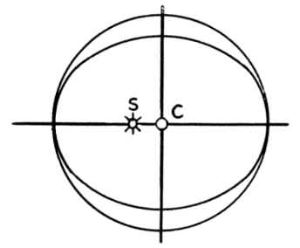The Sleepwalkers (150 page)
Authors: Arthur Koestler

But
in
fact
it
was
not.
The
sun
occupies
not
the
exact
centre
of
the
orbit
at
C;
it
occupies
one
of
the
two
foci
of
the
ellipse
at
S.

Kepler
did
not
know
as
yet
that
the
orbit
was
an
ellipse;
he
still
regarded
it
as
a
circle.
But
even
so,
to
get
approximately
correct
results,
the
centre
of
the
circle
had
to
be
placed
at
C,
and
not
in
the
sun.
Accordingly,
the
question
arose
in
his
mind:
if
the
force
which
moves
the
planets
comes
from
S,
why
do
they
insist
on
turning
round
C
?
Kepler
answered
the
question
by
the
assumption
that
each
planet
was
subject
to
two
conflicting
influences:
the
force
of
the
sun,
and
a
second
force
located
in
the
planet
itself
.
This
tug-of-war
caused
it
now
to
approach
the
sun,
now
to
recede
from
him.
The
two
forces
are,
as
we
know,
gravity
and
inertia.
Kepler,
as
we
shall
see,
never
arrived
at
formulating
these
concepts.
But
he
prepared
the
way
for
Newton
by
postulating
two
dynamic
forces
to
explain
the
eccentricity
of
the
orbits.
Before
him,
the
need
for
a
physical
explanation
was
not
felt;
the
phenomenon
of
eccentricity
was
merely
"saved"
by
the
introduction
of
an
epicycle
or
eccenter,
which
made
C
turn
round
S.
Kepler
replaced
the
fictitious
wheels
by
real
forces.
For
the
same
reason,
he
insisted
on
treating
the
sun
as
the
centre
of
his
system
not
only
in
the
physical
but
in
the
geometrical
sense,
by
making
the
distances
and
positions
of
the
planets
relative
to
the
sun
(and
not
relative
to
the
earth
or
the
centre
C)
the
basis
of
his
computations.
This
shift
of
emphasis,
which
was
more
instinctive
than
logical,
became
a
major
factor
in
his
success.
His
second
innovation
is
simpler
to
explain.
The
orbits
of
all
planets
lie
very
nearly,
but
not
entirely,
in
the
same
plane;
they
form
very
small
angles
with
each
other
–
rather
like
adjacent
pages
of
a
book
which
is
nearly,
but
not
entirely
closed.
The
planes
of
all
planets
pass,
of
course,
through
the
sun
–
a
fact
which
is
self-evident
to
us,
but
not
to
pre-Keplerian
astronomy.
Copernicus,
once
again
misled
by
his
slavish
devotion
to
Ptolemy,
had
postulated
that
the
plane
of
the
Martian
orbit
oscillates
in
space;
and
this
oscillation
he
made
to
depend
on
the
position
of
the
earth
–
which,
as
Kepler
remarks,
"is
no
business
of
Mars".
He
called
this
Copernican
idea
"monstrous"
(though
it
was
merely
due
to
Copernicus'
complete
indifference
to
physical
reality)
and
set
about
to
prove
that
the
plane
in
which
Mars
moves
passes
through
the
sun,
and
does
not
oscillate,
but
forms
a
fixed
angle
with
the
plane
of
the
earth's
orbit.
Here
he
met,
for
once,
with
immediate
success.
He
proved,
by
several
independent
methods,
all
based
on
the
Tychonic
observations,
that
the
angle
between
the
planes
of
Mars
and
Earth
remained
always
the
same,
and
that
it
amounted
to
1°
50
′
.
He
was
delighted,
and
remarked
smugly
that
"the
observations
took
the
side
of
my
preconceived
ideas,
as
they
often
did
before."
5
The
third
innovation
was
the
most
radical.
To
gain
more
elbow
room,
he
had
to
get
out
of
the
straight-jacket
of
"uniform
motion
in
perfect
circles"
–
the
basic
axiom
of
cosmology
from
Plato
up
to
Copernicus
and
Tycho.
For
the
time
being,
he
still
let
circular
motion
stand,
but
he
threw
out
uniform
speed.
Again
he
was
guided
mainly
by
physical
considerations:
if
the
sun
ruled
the
motions,
then
his
force
must
act
more
powerfully
on
the
planet
when
it
is
close
to
the
source,
less
powerfully
when
away
from
it;
hence
the
planet
will
move
faster
or
slower,
in
a
manner
somehow
related
to
its
distance
from
the
sun.